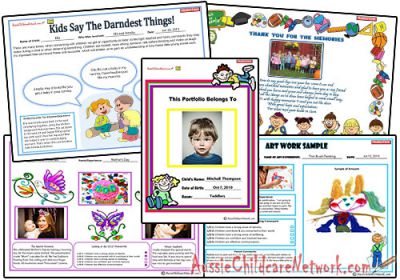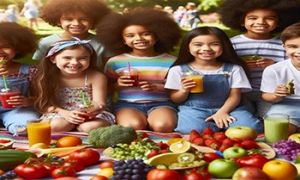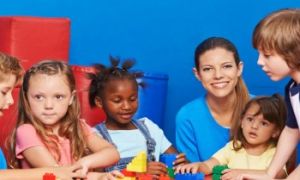Portfolios have become a popular form of documentation used to give families, a keepsake at the end of the year. It is usually a folder containing samples of child’s work and photos of experiences the child was involved in throughout the year. However, it has become much more than a folder for storing artwork and photos so to speak. Portfolios are a journey of a child’s learning....
What are Portfolios?
Portfolios are for individual children and contain a collection of various assessments and documentation that reflects a child’s progress of development and learning. It provides evidence and samples of a child’s achievement throughout the year. For educators, portfolios offer an opportunity to reflect on an individual child’s efforts and achievements over time. For children and families, portfolios enable them to be part of a collaborative approach where all contributions are welcomed and gain an insight and understanding their child’s learning.
What do Portfolios Contain?
Portfolios contain a collection of organised, purposeful information by and about an individual child. Portfolios can include observations, photographic records, learning stories, conversations, reflections, descriptions, questions and analysis and much more.
How to Create Portfolios
There are a variety of ways to create Portfolios. Using individual folders, three ring binders, accordion type files, scrapbooks, a CD-ROM disk per child or completing them online. Educators should find which one suits them best based upon the overall needs of their group of children.
Once a storage tool has been created, Portfolios should be filled methodically with evidence of child’s learning and development. This can be done on a weekly, fortnightly or on a monthly basis.
When filling Portfolios, there are a number of documents that can be added that educators are already completing for each individual child. These include:
- various observations (running records, photos obs, developmental checklists etc)
- individual and group learning stories
- art work samples
- half yearly and yearly reports
- family input and feedback forms and more
As they are being completed they can be directly stored into each child’s portfolio.
The layout of the documentation within the Portfolio can also be categorised into different sections rather than putting all the documents one after another. Sections can include: monthly from January to Dec. Within each of the months, the evidence collected for the child can be placed under the specific month. Another option is to create sections for the different evidence being collected over the year. Such as Learning Stories, Observations, Reports etc. This way it’s easy to find and file the documents under the correct section.
It’s also beneficial to have a Portfolio checklist that lists each child as well each month and what has been added into the portfolios just so it’s easier to keep track of the evidence being collected for each child.
Store Portfolios on a shelf available for parents and children to view at their pleasure. When using CD-ROMs, enable parents to take these home to view for themselves every month or so.
Managing Portfolios
Completing Portfolios can sometimes be a challenge especially when there can be a lot of documentation to add to each child’s Portfolio. The best way to complete children’s Portfolios is to simply work on 2-3 a day rather than trying to complete them all in one go. Try to team Portfolio’s up with the child observations. So when completing a child’s observation on the same day complete their portfolio by adding any other evidence of learning into their Portfolio.
The room leader is responsible for the Portfolios for each child in their group and their responsibility to make sure Portfolios are up to date and up to the standard. Although not all the documentation has to be completed by the room leader themselves. Other educators within the room can share the work load by collecting and organizing parts of the documentation needed to complete individual Portfolios.
Portfolios shouldn’t be considered as a chore or be completed just to give parents something to look at, at the end of the year. It is to be used to share each child’s sense of belonging and wellbeing and to celebrate the process of learning and development of the individual child.
Getting Children and Parents Involved
Each child should be involved in their own Portfolios. They should be given an opportunity to participate in the portfolio process to reflect on and understand their own learning, development, strengths and needs. Encourage children to compare work samples of past and present in order for them to recognize their own progress. Ask questions and comment on photos, art work, work samples by asking “tell me about your work”, “would you draw this differently”, “would you change this, how” etc.
Including children will enable them to feel a sense of pride and a strong sense of ownership of their portfolios. When selecting work samples to add into portfolios, ask the child if they want that particular piece of work displayed in their portfolio. Get the child to also contribute by choosing what they will like to keep within their portfolio or to take home instead.
Encourage each child to share their portfolios with their families. If a new document has been added invite parents to come and see during drop offs. If parents don’t have time have a “Portfolio Day”, where parents come in to look at their child’s portfolio with them. This gives parents an opportunity to look through their child’s learning journey so far. Also encourage parents to comment and leave their feedback on different documentation of learning. This can be done by leaving a parent comment section in some of the evidence being collected and added into the portfolios. Once a parent leaves a comment don’t forget to follow up on it.
Portfolios offer an opportunity for parents to see their child’s developmental progress in action and gain an understanding of what their child’s experiences away from home.
Portfolios on Aussie Childcare Network
We understand that Portfolios are special and more importantly shows the learning journey and achievements of each individual child throughout the year. The Portfolio templates available in Templates on this website have been designed with simplicity in mind.
Some of the Portfolio templates that are available include: Family Input Forms, Work Sample Templates, Poems, Yearly Reports, Special Moments, Learning Stories and many more.
The Portfolio templates are bright and colourful, attractively designed, professional looking, links to the EYLF and curriculum and all you need to use to create a complete Portfolio.
Click here to view these Portfolio Templates: Portfolio Templates







 Here is the list of the EYLF Learning Outcomes that you can use as a guide or reference for your documentation and planning. The EYLF
Here is the list of the EYLF Learning Outcomes that you can use as a guide or reference for your documentation and planning. The EYLF The EYLF is a guide which consists of Principles, Practices and 5 main Learning Outcomes along with each of their sub outcomes, based on identity,
The EYLF is a guide which consists of Principles, Practices and 5 main Learning Outcomes along with each of their sub outcomes, based on identity, This is a guide on How to Write a Learning Story. It provides information on What Is A Learning Story, Writing A Learning Story, Sample
This is a guide on How to Write a Learning Story. It provides information on What Is A Learning Story, Writing A Learning Story, Sample One of the most important types of documentation methods that educators needs to be familiar with are “observations”. Observations are crucial for all early childhood
One of the most important types of documentation methods that educators needs to be familiar with are “observations”. Observations are crucial for all early childhood To support children achieve learning outcomes from the EYLF Framework, the following list gives educators examples of how to promote children's learning in each individual
To support children achieve learning outcomes from the EYLF Framework, the following list gives educators examples of how to promote children's learning in each individual Reflective practice is learning from everyday situations and issues and concerns that arise which form part of our daily routine while working in an early
Reflective practice is learning from everyday situations and issues and concerns that arise which form part of our daily routine while working in an early Within Australia, Programming and Planning is reflected and supported by the Early Years Learning Framework. Educators within early childhood settings, use the EYLF to guide
Within Australia, Programming and Planning is reflected and supported by the Early Years Learning Framework. Educators within early childhood settings, use the EYLF to guide When observing children, it's important that we use a range of different observation methods from running records, learning stories to photographs and work samples. Using
When observing children, it's important that we use a range of different observation methods from running records, learning stories to photographs and work samples. Using This is a guide for educators on what to observe under each sub learning outcome from the EYLF Framework, when a child is engaged in
This is a guide for educators on what to observe under each sub learning outcome from the EYLF Framework, when a child is engaged in The Early Years Learning Framework describes the curriculum as “all the interactions, experiences, activities, routines and events, planned and unplanned, that occur in an environment
The Early Years Learning Framework describes the curriculum as “all the interactions, experiences, activities, routines and events, planned and unplanned, that occur in an environment


